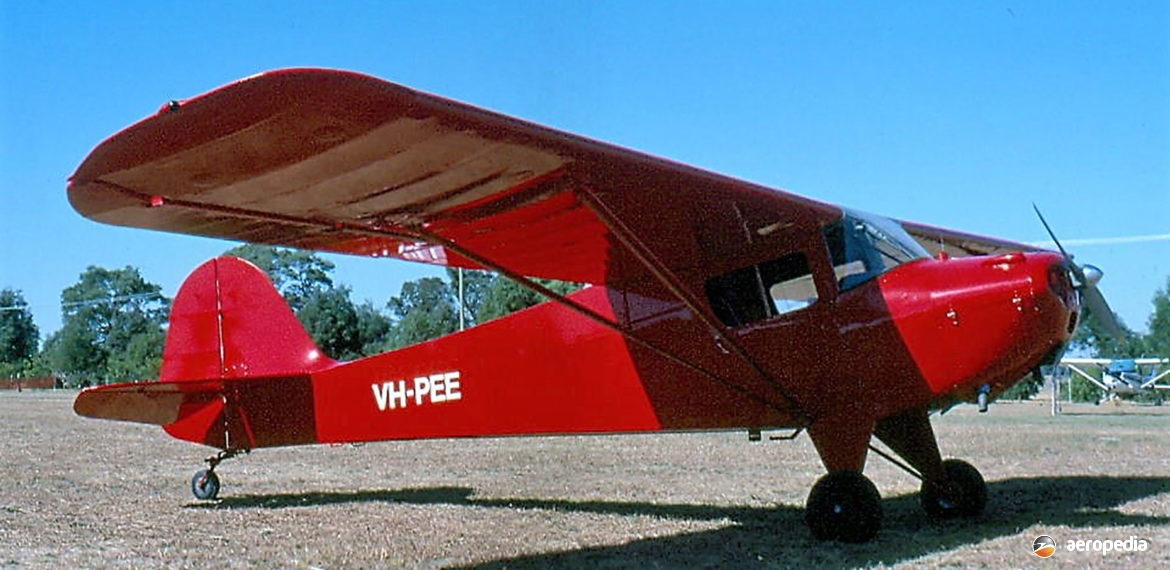Photograph:
Taylorcraft BC-12D-65 VH-PEE (c/n 8256) at Cowra, NSW in 1995 (David C Eyre)
Country of origin:
United States of America
Description:
Two-seat light touring monoplane
Power Plant:
One 48 kw (65 hp) Continental A65 four-cylinder horizontally-opposed air-cooled engine
Specifications:
- Wingspan: 11 m (36 ft)
- Length: 6.7 m (22 ft)
- Height: 2 m (6 ft 8 in)
- Wing area: 17 m² (183.5 sq ft)
- Max speed: 177 km/h (110 mph)
- Cruising speed: 153 km/h (95 mph)
- Initial rate of climb: 183 m/min (600 ft/min)
- Service ceiling: 5,182 m (17,000 ft)
- Max range: 804 km (500 miles)
- Empty weight: 304 kg (670 lb)
- Loaded weight: 522 kg (1,150 lb)
History:
In 1936 the Taylorcraft Aviation Company was formed by C G Taylor, a former President and Chief Engineer of the Taylor Aircraft Company, to produce the Model A, a two-seat light aircraft. This was very similar to the Taylor Cub (later known as the Piper Cub) with the main difference being the two-seats side-by-side in the Model A instead of in tandem.
In 1937 the Taylor-Young Airplane Company was formed to take over production of the Model A. Production continued until 1939 when the Model B line was commenced. The Model B was a refined version of the Model A, and in its initial production series the Model B was powered by a variety of power plants, including engines from Continental, Franklin, or Lycoming in the 37 kw (50 hp) range, depending on customer preference.
In 1940 it was decided to standardise on three basic engines, the 48 kw (65 hp) Continental A65, the Franklin 4AC-176, and the Lycoming O-145-B2. The models then became known as the BC, BF and BL respectively. A training model was released then and became known as the BT. By the time pre-war production concluded, a total of 2,401 Model Bs had been completed.
In 1941 a deluxe model incorporated various features to add to the comfort of persons on board, and this became known as the B-12. The various models available then became the BC-12 for Continental-powered models, FC-12 for Franklin-powered models, and LC-12 for the Lycoming-engined variant. Production was suspended at the request of the American Government during World War II, and resumed in 1945. A new model was released with a strengthened fuselage structure and other minor changes. The new models then became known as the BC-12D, FC-12D, and LC-12D, with the name ‘Twosome’ being added.
In recent years, following the introduction of S-LSA design rules in the United States for ultralight aircraft, Taylorcraft Aviation introduced the 2006 Taylor Sport, this being the latest incarnation of the Taylorcraft BC-12 and, powered by a 75 kw (100 hp) Continental TMC O-200, with the structure remaining the same as the original aircraft, it was offered to the sports pilot in completed form.
One BC-12D has been registered in New Zealand for some years now as ZK-BSW (c/n 7512) and one has been registered in Australia as VH-PEE³ (c/n 8256 – ex N95956, NC95956) since 1994, being based at Gunnedah, NSW. Another BCY-2D has operated in New Zealand near Auckland under its US registration N44022 (c/n 9822). In late 2011 a BL-65 was imported to Australia, becoming VH-TZK (c/n 2782) to its owner Robert Glenn of Canowindra, NSW on 29 November.

